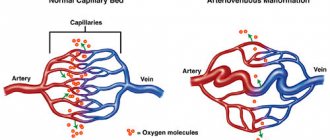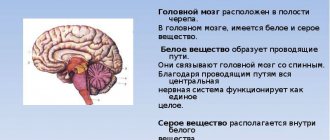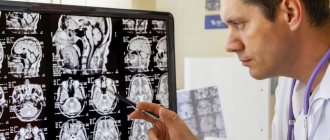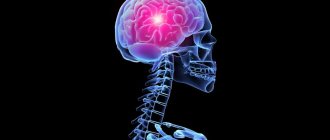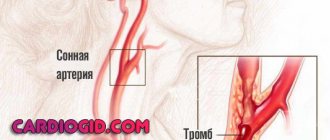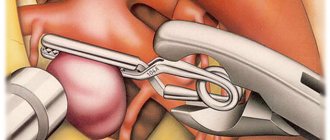02 Sep 2021 at 14:47 MRI of the head in Tushino 7910
According to current statistics, cerebral ischemia is diagnosed in every fourth resident of our country. As a rule, this phenomenon is age-related, however, its symptoms are increasingly observed among representatives of the younger generation (up to 40 - 45 years). In order to minimize the negative consequences of this dangerous disease, it is necessary to promptly contact specialists and listen to their professional recommendations.
General information about cerebral ischemia
A disease in which blood circulation to the brain is reduced or completely stopped is called ischemia. The cause of the disorder is a pathological narrowing of the lumen of blood vessels, in which oxygen does not flow in the required volume. Lack of nutrition leads to malfunctions, which are expressed by general malaise and other symptoms.
Medicine has identified two forms of the disease:
- Focal
- in which tissue damage is localized in only one area. The cause is an embolism or blood clot that blocks the blood flow. - Global
- characterized by a decrease or cessation of blood circulation in several areas of the brain.
As a result of oxygen starvation of tissues, ischemia develops. With early diagnosis, complications of the disease can be avoided.
Classification of cerebral ischemia
The deterioration of vascular activity occurs with varying degrees of severity, therefore two types of the disease are distinguished:
- Acute
, characterized by the suddenness of the onset of symptoms and the minimum period of development of the disease (stroke, cerebral infarction). - Chronic
, occurs as a result of the slow development of brain dysfunction due to diffuse (extensive) or small focal damage to brain tissue in conditions of prolonged insufficiency of cerebral blood supply. In this condition, patients develop symptoms gradually, with further progression.
Vascular pathology occurs not only in adults, but even in newborns due to a lack of oxygen during the mother’s pregnancy.
Symptoms and stages of development of chronic cerebral ischemia
Chronic ischemia of the brain is a progressive disease, which is accompanied by increasing disturbances in the functioning of the central, peripheral and autonomic nervous systems. The first signs of the disease often go unnoticed, since they do not have any acute manifestations, but are expressed in general malaise, headaches, drowsiness, absent-mindedness, irritability. Usually this condition is attributed to overwork or age-related changes, however, the onset of cerebral ischemia may be hidden under it. It is very important to seek medical help in a timely manner.
Manifestations of chronic cerebral ischemia are divided into three stages: initial manifestations, subcompensation and decompensation.
Stage 1 is dominated by subjective disorders in the form of headaches and a feeling of heaviness in the head, general weakness, increased fatigue, emotional lability, dizziness, decreased memory and attention, and sleep disturbances. These phenomena are accompanied, although mild, but quite persistent objective disorders in the form of anisoreflexia (difference in symmetrical tendon reflexes), discoordination phenomena, oculomotor insufficiency, symptoms of oral automatism, memory loss and asthenia. At this stage, as a rule, the formation of distinct neurological syndromes (except for asthenic) has not yet occurred, and with adequate therapy, it is possible to reduce the severity or eliminate both individual symptoms and the disease as a whole.
The complaints of patients with the 2nd stage of CCI more often include memory impairment, loss of ability to work, dizziness, instability when walking, and manifestations of an asthenic symptom complex are less often present. At the same time, focal symptoms become more distinct: revival of reflexes of oral automatism, central insufficiency of the facial and hypoglossal nerves, coordination and oculomotor disorders, pyramidal insufficiency, amyostatic syndrome, increased mnestic-intellectual disorders. At this stage, it is possible to identify certain dominant neurological syndromes - discoordination, pyramidal, amyostatic, dysmnestic, etc., which can help in prescribing symptomatic treatment. At this stage, the patient’s social and work activity is already disrupted; in some cases, even in everyday affairs, the help of strangers is already required. It is impossible to completely reverse the changes that have occurred in the nervous system, but it is possible to neutralize the symptoms and slow down the progression of the disease.
At the 3rd stage of CCI, objective neurological disorders in the form of discoordination, pyramidal, pseudobulbar, amyostatic, and psychoorganic syndromes are more pronounced. Paroxysmal conditions—falls, fainting—are more common. In the stage of decompensation, cerebral circulation disorders are possible in the form of “small strokes” or prolonged reversible ischemic neurological deficit, the duration of focal disorders in which ranges from 24 hours to 2 weeks. At the same time, the clinical picture of diffuse insufficiency of blood supply to the brain corresponds to that of moderate encephalopathy. Another manifestation of decompensation may be a progressive “complete stroke” and residual effects after it. This stage of the process with diffuse damage corresponds to the clinical picture of severe encephalopathy. Focal symptoms are often combined with diffuse manifestations of brain failure. Treatment at this stage is rather supportive in nature, since most of the brain damage and functions lost as a result are irreversible.
Along with the progression of neurological symptoms, as the pathological process develops in the neurons of the brain, an increase in cognitive disorders occurs. This applies not only to memory and intelligence, which are impaired in the 3rd stage to the level of dementia, but also to such neuropsychological syndromes as praxis (the ability to perform successive complexes of conscious voluntary movements and perform purposeful actions according to a plan developed by individual practice) and gnosis (recognition of objects ( objects, persons) with the preservation of elementary forms of sensitivity, vision, hearing. Initial, essentially subclinical disorders of these functions are observed already in the 1st stage, then they intensify, change, and become distinct. The 2nd and especially 3rd stages of the disease are characterized by severe disorders of higher brain functions, which sharply reduces the quality of life and social adaptation of patients.
Regardless of at what stage signs of chronic cerebral ischemia are detected, it is important to consult a doctor as quickly as possible, since at an early stage of the disease the changes are still reversible, and at later stages it is possible to stop the progression of the disease and improve the quality of life and social adaptation.
Symptoms of cerebral ischemia
In the case of an acute process (hemorrhagic or ischemic stroke), the first signs of the disease appear brightly and clearly; with timely diagnosis, treatment can be quickly started with a favorable prognosis in the future. Symptoms in this case will depend on the area of brain damage.
With chronic ischemia, the following appear:
- deterioration of brain activity,
- deterioration of intellectual development,
- depression of the psycho-emotional state (irritability, apathy, hysteria, depression, insomnia).
Concentration of attention during mental stress is impaired, fatigue and anxiety appear. The appearance of such symptoms goes unnoticed by a person for a long time, and the disease develops to an irreversible process.
Over time, patients experience the following symptoms in addition to the above:
- headache;
- nausea, vomiting;
- dizziness;
- lack of coordination when walking;
- deterioration of sensitivity in the limbs;
- depression of visual and auditory function;
- fainting.
Lack of adequate treatment for the disease leads to dementia (dementia). In this case, patients partially or completely lose work skills and the ability to self-care.
To prevent dangerous complications of chronic cerebral ischemia, you need to undergo diagnosis and begin treatment.
Chronic cerebral ischemia - symptoms and treatment
The diagnosis of chronic cerebral ischemia is often a diagnosis of exclusion (that is, a diagnosis made after excluding all other causes) [6]. Diagnosis is especially difficult in the early stages, when the symptoms of the disease are quite nonspecific and can be disguised as depression and neurotic disorders. Therefore, diagnostics are always comprehensive, including a detailed anamnesis, various laboratory and clinical diagnostic methods, consultation with doctors of other specialties and neuropsychological diagnostics.
A detailed medical history includes a conversation with relatives or the patient’s immediate circle to determine risk factors, the presence of concomitant diseases, and the nature of disease progression.
Examination of neurological status : during an examination of the patient, a neurologist checks muscle strength, sensitivity in different areas of the skin, reflexes (using a neurological hammer), accuracy of movements, stability when standing and walking. Based on the examination, the doctor determines the areas of brain damage (topical diagnosis).
Neuroimaging methods: CT, MRI of the brain, MR angiography (cerebral arteries and veins), if necessary, radiopaque cerebral angiography. Neuroimaging allows you to exclude other diseases (tumor, hydrocephalus) and confirm the vascular nature of the disorders. MRI of the brain is preferable, which reveals changes characteristic of chronic cerebral ischemia:
- leukoaraiosis - a change in the white matter around the ventricles of the brain (in Figure 1, white glow around the ventricles);
- lekoencephalopathy - damage to the white matter of the brain (in Figures 1 and 3, light areas in the subcortical substance);
- small heart attacks, ischemic strokes ( Figure 3);
- multiple microbleeds (Figure 2 - dark areas);
- atrophy of the cerebral cortex.
There is a relationship between the type and severity of morphological changes in the medulla and the stage of the disease [4][6].
A neuropsychological examination allows us to identify the severity and nature of cognitive and emotional disorders, and determine intact functions that can be relied upon in subsequent neurocorrectional work.
The examination is carried out by a neuropsychologist using special tasks: tests of attention, memory, speech, thinking, and motor coordination. Ultrasound of the vessels of the neck and brain allows us to identify signs of hypertensive angiopathy: thickening and uneven internal surface of the vessels, deformation, bends, tortuosity, decreased blood flow speed, as well as signs of atherosclerosis: the number of atherosclerotic plaques, the percentage of vascular stenosis, the degree of danger of the plaque (whether the plaque or its fragment comes off and clogs the vessel).
ECG, Holter monitoring and 24-hour blood pressure monitoring are necessary to determine the severity of cardiovascular disease as the main causative factor of chronic cerebral ischemia [4].
Consultation with doctors of other specialties (general practitioner, endocrinologist, gastroenterologist, nephrologist, nutritionist) is necessary for timely detection and treatment of concomitant diseases.
A general clinical blood test, a study of lipid and carbohydrate metabolism, indicators of kidney function (creatinine, urea) and liver (bilirubin, transaminases) are necessary to identify and correct metabolic disorders.
Diagnosis of cerebral ischemia
To identify a dangerous disease, neurologists use an integrated approach to diagnosis. During the examination, the doctor collects anamnesis and conducts a primary examination, for example, a finger-nose test. To do this, the patient is asked to stand up, align his legs shoulder-width apart, spread his arms to the sides, bending them at an angle of 90 degrees, and close his eyes. Next, the patient should touch the tip of the nose with the index finger. With developing ischemia, contact between the two surfaces will not occur, and the missed finger will certainly point in the direction of the damaged lobe.
In addition to the finger-nose test, the doctor will examine other abilities of the patient, such as facial expressions, pupil reaction, facial symmetry, clarity of speech and coordination. Along with the examination, the necessary tests are additionally collected:
- Blood pressure is measured in a doctor's office.
- Detection of vascular lesions of the fundus is carried out by an ophthalmologist.
- Undergoing electrocardiography for correct diagnosis.
- Dopplerography of blood vessels is mandatory.
- Electroencephalography reveals inactive areas of the brain.
- CT (computed tomography), MRI (magnetic resonance imaging) perform an in-depth examination.
- A biochemical blood test evaluates cholesterol levels.
Doctors use differential diagnostic methods, since the symptoms of the pathology are similar to the manifestations of other diseases of an infectious, allergic, neurological and oncological nature.
Treatment of ischemic cerebral disease
Therapy for cerebral vascular ischemia consists of a conservative (medicinal) treatment method and a surgical one. The first method is aimed at improving vascular tone and blood pressure. The doctor will adjust the patient’s diet to eliminate the risk of the formation of atherosclerotic plaques and blood clots. But if they are already present, additional medications are prescribed in addition to the diet. In most cases, it is hypertension and atherosclerosis that are the root cause of the development of ischemia.
Drug treatment consists of the following:
- antihypertensive, reducing blood pressure in the vessels;
- lipid-lowering drugs (statins), which reduce cholesterol deposits;
- antiplatelet, blood thinning, preventing the formation of blood clots;
- nootropic, normalizing brain functioning;
- antioxidant, improving oxygen supply to tissues;
- anxiolytics and sedatives that reduce the manifestations of hyperexcitability.
Chronic ischemia requires more in-depth diagnosis, as well as radical treatment. Surgery is often necessary:
- stenting of the carotid arteries - expansion of the narrowing site using a metal tube;
- carotid endarterectomy - removal of plaque from the carotid arteries.
If the cause of chronic vascular disease is a blood clot or plaque, then during surgery they will be removed, which allows the patient to return normal vascular tissue, which will supply the brain with oxygen in full.
Neurologists advise not to overwork, get enough sleep and lead a healthy lifestyle, since discirculatory encephalopathy does not result in a quick recovery without following a diet and changing lifestyle.
Rehabilitation after surgery
Further rehabilitation measures consist of the following stages:
- Rehabilitation in a hospital setting during the patient’s hospitalization.
- Rehabilitation in a hospital department or in a sanatorium after the end of the acute period of illness.
- Outpatient clinic or home.
Causes of development of chronic cerebral ischemia
The causes of the development of chronic cerebral ischemia are closely related to atherosclerotic stenosis, thrombosis, and embolism. A certain role is played by post-traumatic dissection of the vertebral arteries, extravasal (extravascular) compression due to pathology of the spine or neck muscles, deformation of the arteries with constant or periodic disturbances in their patency, and hemorheological changes in the blood. It must be borne in mind that symptoms similar to those that occur with chronic ischemia can be caused not only by vascular, but also by other factors - chronic infection, neuroses, allergic conditions, malignant tumors and other reasons with which a differential diagnosis should be made .
Signs of impaired cerebral blood flow are observed in the following diseases:
- hypertension,
- atherosclerosis,
- hypotension,
- vasculitis (inflammation of blood vessels) of allergic and infectious etiology,
- thromboangiitis obliterans,
- skull injuries,
- abnormalities of the cerebral vascular bed and aneurysms,
- disturbances in cardiac activity,
- blood diseases,
- endocrine pathology,
- kidney diseases and other diseases.
The development of chronic cerebral ischemia is promoted by a number of reasons, which are commonly called risk factors. Risk factors are divided into correctable and non-correctable. Uncorrectable factors include old age, gender, and hereditary predisposition. It is known, for example, that a stroke or encephalopathy in parents increases the likelihood of vascular diseases in children. These factors cannot be influenced, but they help to identify in advance those at increased risk of developing vascular pathology and help prevent the development of the disease. The main correctable factors in the development of chronic ischemia are atherosclerosis and hypertension. Diabetes mellitus, smoking, alcohol, obesity, insufficient physical activity, poor nutrition are the reasons that lead to the progression of atherosclerosis and the deterioration of the patient’s condition. In these cases, the blood coagulation and anticoagulation system is disrupted, and the development of atherosclerotic plaques is accelerated. Due to this, the lumen of the artery is reduced or completely blocked. At the same time, the crisis course of hypertension is especially dangerous: it leads to an increase in the load on the blood vessels of the brain.
Forecast and prevention of cerebral ischemia
When the first symptoms occur, the patient should visit a neurologist. Timely treatment will help prevent complications and an undesirable prognosis for the patient. Ischemia of the blood vessels of the head against the background of high blood pressure progresses quickly, so the patient’s concern for his health should begin with an examination by a doctor.
Prevention of vascular exacerbations includes following a diet, quitting smoking, alcohol, weight control, and avoiding stress. In case of aggravating factors (diabetes, hypertension), observation by a specialist should be systematic. Doctors do not recommend long periods of physical activity or frequent sun exposure for elderly patients.
How to maintain quality of life for people with cerebral ischemia
— Irina Leonidovna, in simple words, what kind of disease is cerebral ischemia? — Cerebral ischemia can be divided into acute and chronic. Acute - cerebral stroke - ranks second in the frequency of deaths from diseases of the circulatory system in Russia. Stroke is an emergency condition, therefore all patients with acute cerebrovascular accident (ACVA), both stroke and transient ischemic attack, should be hospitalized in specialized departments for the treatment of such patients. Assistance before the ambulance arrives or during the patient’s delivery to a medical facility consists of monitoring and maintaining the functioning of the patient’s cardiovascular and respiratory systems.
Chronic cerebral ischemia (CHI) is a slowly progressive brain dysfunction resulting from diffuse and/or small-focal damage to brain tissue in conditions of long-term insufficiency of cerebral blood supply. The concept of “chronic cerebral ischemia” includes “dyscirculatory encephalopathy”, “vascular encephalopathy”, “cerebrovascular insufficiency”, “atherosclerotic encephalopathy”. In the initial stages, chronic ischemia can be manifested by decreased mental performance, mood changes, headache, dizziness and other symptoms.
— What is the diagnosis? — The main diagnostic tests to establish this diagnosis on an outpatient basis include a general blood and urine test, biochemical tests (urea, creatinine, bilirubin, total protein, cholesterol, glucose and other indicators), coagulogram (determination of blood clotting, hematocrit), ultrasound vessels of the head and neck. Based on the results of these examinations, the doctor decides on the patient’s treatment tactics. In addition, it is necessary to clarify the reason that could lead to the onset of the first symptoms. These may be diseases such as myocardial infarction, cardiac ischemia, angina pectoris, arterial hypertension, atherosclerosis of the arteries of the head, neck, extremities, diabetes mellitus and others.
— Who can develop chronic cerebral ischemia and how to avoid it? — Risk factors for development include physical inactivity, obesity, stress, smoking, and alcohol abuse. Moreover, it is necessary to treat diseases such as diabetes, hypertension, atherosclerosis only under the supervision of a doctor. In case of the first signs of the disease, immediately stop smoking, limit the consumption of alcoholic beverages, reduce intense physical activity, and avoid prolonged exposure to the sun. You should be examined by a doctor in a timely manner, since a timely diagnosis and adequate treatment will help stop the progression of the disease.
- But many patients prefer the position “everything will go away on its own”... - If the disease is not controlled, it will lead to acute cerebral ischemia and associated pathologies, which will reduce the quality of life. The main goal of treatment for CICM is to stabilize the destructive process of cerebral ischemia, as well as to take preventive measures against strokes, both primary and recurrent.
— What kind of measures are these and who should especially pay attention to their health? — Primary prevention includes measures to control blood pressure, heart rate, blood sugar levels, blood lipids, the state of the blood coagulation system, body weight regulation, giving up bad habits (alcohol abuse, smoking), and physical activity.
It is especially important to pay attention to your health for women over 50 and men over 45 who have high and, conversely, low blood pressure, suffer from heart failure, arrhythmia, diseases accompanied by the formation of blood clots, patients with diabetes and long-term smokers.
Secondary preventive measures are carried out for patients who have already suffered an acute cerebral circulatory disorder, stroke, heart attack, hemorrhage. They consist of taking measures to prevent the development of a recurrent vascular accident. Chronic cerebral ischemia is very common. And only systemic treatment of the disease can prevent recurrent brain disorders. Proper treatment will help prevent cerebral infarction. The prognosis is good for those patients who are constantly under the supervision of their neurologist. Moreover, preventive measures to prevent the development of this disease should be carried out at any age.
— How to preserve the quality of life for people with cerebral ischemia? — The main goal is to slow down the progression of the disease. The selection of adequate drug therapy (if indicated) and preventive measures aimed at normalizing blood pressure, lipid levels, cholesterol and blood glucose will help improve the quality of life. The use of a number of drugs, including antiplatelet and antioxidant effects, will also help. Antiplatelet agents reduce blood clotting and improve its properties. Antioxidants and antihypoxants bind free radicals, slowing down oxidation processes. They increase the body's resistance to oxygen deficiency, influence intracellular redox processes indirectly, facilitating the transition of oxygen from the blood to tissues, improving blood supply to the brain. Non-drug preventive measures will also help: physiotherapy, occupational therapy, hydrokinesitherapy, regular motor and mental activity.
— Does CIGM affect intelligence and memory? — Chronic cerebral ischemia, occurring against the background of atherosclerosis, hypertension, or a combination of them, causes the development of motor and cognitive disorders. One of its main manifestations is a decrease in memory and speed of thinking, leading to impairments in social adaptation, self-care and communication. These are precursors to the development of vascular dementia. Given the increasing life expectancy, neuropsychological rehabilitation of such patients is becoming an increasingly pressing medical and social problem.
The disease can also manifest itself as disturbances in the emotional sphere: anxiety, depression, apathy, decreased reaction speed, difficulty concentrating, increased fatigue during mental work. Therefore, patients with initial manifestations of decreased memory and thinking deserve close attention; adequate treatment of them before the development of pronounced disorders can be quite effective.
— Older people are more likely to suffer from chronic cerebral ischemia. What should they, their family and friends pay attention to? — It is very important for the timely identification of patients with a high risk of subsequent development of dementia (dementia), so that the elderly patient himself or his relatives pay attention to the first signs of memory loss as early as possible.
In addition, to prevent dementia in the elderly, it is important to provide them with an adequate level of physical activity, quit smoking, and improve their educational level. The first manifestations of memory impairment, gait, falling, loss of balance should alert all elderly people and their relatives.
— What should patients with this diagnosis remember? — About the constant prevention of your illness. That first of all you need to lead a healthy lifestyle. Strictly monitor and treat arterial hypertension, diabetes mellitus, atherosclerosis. Be trained in health schools organized on the basis of health centers of territorial clinics.

